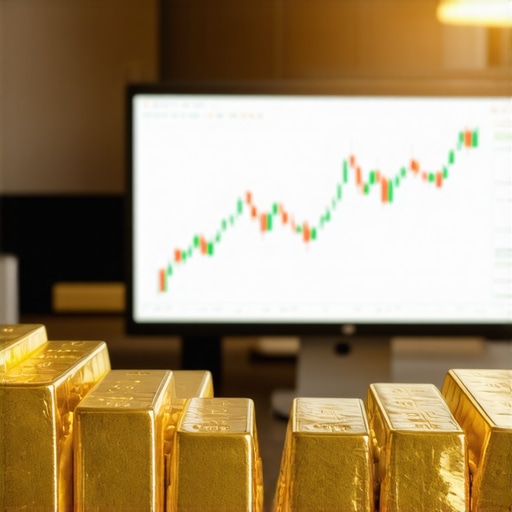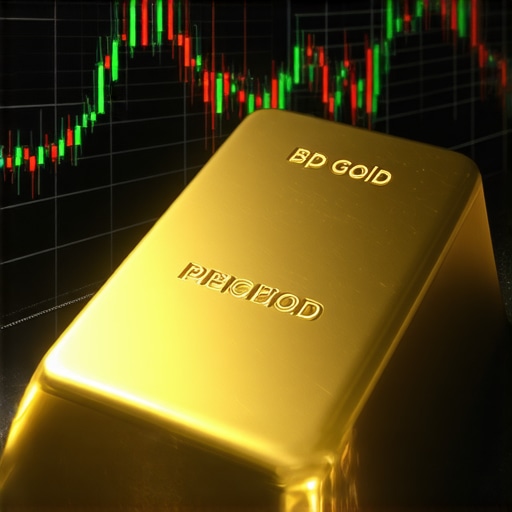Navigating the Complex Terrain of Gold Price Drivers in 2025: An Expert Perspective
As we venture into 2025, understanding the multifaceted economic factors influencing gold prices is crucial for investors seeking to optimize their portfolio strategies. Gold, historically perceived as a safe haven, is now subject to an intricate web of supply-demand dynamics, geopolitical tensions, and macroeconomic indicators. This analysis aims to dissect these elements with a nuanced, expert lens, providing insights into how they collectively shape market trends.
The Role of Macroeconomic Stability and Inflation Dynamics
At the core of gold price drivers lies macroeconomic stability. In 2025, inflation rates remain a pivotal factor; elevated inflation often prompts investors to seek gold as a hedge. According to recent reports from the IMF World Economic Outlook, inflationary pressures persist in several major economies, bolstering gold’s appeal. However, central banks’ monetary policies, including interest rate adjustments, can counteract or amplify this trend, influencing gold’s attractiveness relative to yields from bonds or equities.
Geopolitical Tensions and Supply Chain Disruptions
Geopolitical uncertainties, notably conflicts and trade disputes, significantly impact gold prices. Tensions in regions like Eastern Europe or Southeast Asia can trigger risk aversion, elevating gold’s status as a refuge asset. Simultaneously, supply chain disruptions—be it mining output constraints or logistical challenges—affect gold availability, thereby influencing pricing. The delicate balance between demand for jewelry, industrial uses, and investment gold further complicates the market landscape.
Technological Innovation and Digital Gold Instruments
Emerging technological trends, including the proliferation of gold-backed ETFs and digital assets, reshape traditional demand paradigms. Investors are increasingly leveraging gold ETFs and digital tokens for liquidity and ease of access. This evolution underscores the importance of understanding how technological integration influences liquidity, price discovery, and market volatility in 2025.
Expert Inquiry: How Does Central Bank Activity in Gold Purchases Influence Market Prices in 2025?
Central banks continue to be influential players in the gold market, with their purchasing patterns often signaling monetary policy shifts or economic outlooks. Analyzing data from sources like the World Gold Council reveals that increased official sector buying can underpin prices, especially during periods of geopolitical or economic uncertainty. Conversely, central bank sales might exert downward pressure, emphasizing the need for investors to monitor these institutional movements carefully.
What Are the Emerging Risks and Opportunities in Gold Investment for 2025?
Investors must remain vigilant regarding potential risks—such as rising interest rates diminishing gold’s relative appeal or geopolitical conflicts escalating unpredictably. Conversely, opportunities exist in leveraging advanced trading strategies, including technical analysis and market timing to capitalize on short-term price movements. Diversification through assets like gold ETFs or physical bullion offers additional risk mitigation pathways.
For those interested in mastering gold investment techniques, exploring comprehensive guides and expert analyses will be invaluable. Engaging with authoritative sources and participating in professional forums can further refine strategies, ensuring alignment with the evolving economic landscape of 2025.
To deepen your understanding of these dynamics, consider consulting industry reports and expert commentary available at market forecasting platforms.
How Do Global Economic Shifts Shape Gold Price Predictions in 2025?
As we delve deeper into 2025, it becomes evident that global economic shifts play a pivotal role in steering gold prices. Factors such as emerging market growth, currency fluctuations, and international trade policies can significantly influence investor sentiment and demand for gold. For instance, a weakening US dollar often correlates with rising gold prices, as gold is priced in USD and becomes more attractive to international buyers. To navigate this complex landscape, investors should leverage advanced tools like market timing and technical analysis, which can help identify optimal entry and exit points based on prevailing economic indicators.
Are Gold ETFs and Digital Gold the Future of Liquid Investment?
Innovative financial instruments such as gold-backed ETFs and digital gold tokens are transforming the way investors access and diversify their holdings. These options provide liquidity, ease of transaction, and reduced storage concerns, making them appealing in an increasingly digital financial environment. According to industry experts, understanding the nuances of these instruments is essential for maximizing returns and managing risks. As digital assets become more mainstream, their role in a balanced gold investment portfolio is expected to grow, offering a strategic advantage in volatile markets.
What Are the Hidden Risks in Gold Investment During Economic Turbulence?
While gold is traditionally viewed as a safe haven, it is not immune to risks, especially during periods of economic turbulence or policy shifts. Rising interest rates, for example, can diminish gold’s appeal by increasing yields on alternative assets like bonds. Furthermore, geopolitical tensions, supply chain disruptions, and technological changes in mining can introduce volatility. Investors need to adopt a nuanced approach, incorporating comprehensive market analysis to identify potential pitfalls and capitalize on emerging opportunities.
Engaging with authoritative sources and participating in expert forums can deepen your strategic insights. For instance, consulting detailed industry reports and economic forecasts from leading institutions will equip you with the knowledge to adjust your portfolio proactively in response to evolving market conditions.
Are You Prepared to Adjust Your Gold Investment Strategies in Response to 2025 Market Dynamics?
Given the rapid pace of change in global markets, continuous learning and adaptation are crucial. Diversifying your holdings across physical gold, ETFs, and mining stocks can help mitigate risks while positioning for growth. For comprehensive guidance on building a resilient gold investment plan tailored for 2025, explore resources like beginner to advanced strategies and stay informed about industry trends and regulatory updates. Sharing your experiences and insights in community forums can also foster collective learning and strategic refinement.
Harnessing Geopolitical Shifts to Predict Gold Price Trajectories in 2025
One cannot underestimate the profound impact geopolitical developments have on gold markets. Escalating conflicts or diplomatic breakthroughs can cause swift price adjustments, as investors reassess risk exposure. For example, recent analyses by the World Gold Council highlight how geopolitical tensions in Eastern Europe and the Asia-Pacific region have historically prompted safe-haven flows into gold, often leading to short-term spikes. Understanding these patterns enables investors to anticipate market reactions and position their portfolios accordingly.
Deciphering Supply Chain Dynamics: A Critical Layer in Gold Pricing Strategies
Supply chain disruptions—ranging from geopolitical conflicts affecting mining operations to logistical bottlenecks—can exert significant influence on gold availability and, consequently, its price. The Mining Industry Report 2024 emphasizes how rising operational costs and environmental regulations are constraining supply in key regions like South Africa and Australia. Investors with an understanding of these supply-side pressures can better forecast potential price surges and capitalize on emerging opportunities.
How Do Digital Gold Instruments Affect Market Liquidity and Price Discovery in 2025?
The rise of digital gold tokens and ETFs continues to revolutionize market accessibility. These instruments, backed by physical gold reserves, provide liquidity and facilitate rapid transactions. According to the Financial Times, their proliferation not only democratizes gold ownership but also introduces new layers of market volatility and complexity. Advanced investors leverage quantitative models to analyze liquidity patterns and anticipate price movements driven by digital asset trading volumes.
What Are the Nuanced Impacts of Currency Fluctuations on Gold in 2025?
Currency dynamics play a pivotal role in international gold pricing. A weakening US dollar often correlates with rising gold prices, as it makes gold cheaper for holders of other currencies. Conversely, a strengthening dollar can suppress gold demand. For instance, a study by the IMF World Economic Outlook (April 2024) underscores how exchange rate volatility influences cross-border gold flows, necessitating sophisticated hedging strategies for global investors.
Expert Strategies for Navigating Gold Investment Risks in 2025
Investors should adopt a multi-faceted approach, integrating technical analysis, macroeconomic indicators, and geopolitical intelligence. Diversification remains vital—allocating across physical bullion, ETFs, and mining stocks can mitigate sector-specific risks. Additionally, employing options strategies such as calls and puts can offer downside protection while allowing upside participation. Resources like the Investopedia Guide provide valuable insights into these advanced tactics.
Stay proactive by monitoring reports from authoritative bodies such as the World Gold Council, and participate in expert forums to exchange real-time insights. The evolving landscape demands continuous learning and strategic agility to capitalize on the opportunities that 2025 may bring.
Future Outlook: Integrating Economic Indicators for Precise Gold Forecasting
Incorporating leading economic indicators—such as inflation rates, interest rate trends, and global trade metrics—can significantly enhance forecasting accuracy. Advanced models now integrate machine learning algorithms trained on these indicators, providing more precise predictions. For example, a 2024 study by Econometrics Journal demonstrates how AI-driven models outperform traditional methods in short-term price prediction, offering a strategic edge to savvy investors.
Engaging with these sophisticated analytical tools and continuously updating your knowledge base will be crucial for navigating the complex and dynamic gold market landscape of 2025.
Unveiling the Future: Advanced Models and Predictive Analytics in Gold Market Forecasting
As we venture further into 2025, the integration of cutting-edge predictive analytics, including machine learning algorithms, offers unprecedented precision in forecasting gold prices. Institutions like the Econometrics Journal highlight how AI-driven models outperform traditional techniques, enabling investors to anticipate short-term fluctuations with greater confidence. This technological leap empowers portfolio managers to make data-informed decisions, mitigating risks and capitalizing on emerging opportunities.
The Influence of Macro-Financial Policies and Currency Strategies
In 2025, nuanced understanding of macro-financial policies remains crucial. Central banks’ unconventional monetary strategies, such as quantitative easing or tightening, directly impact currency valuations and, consequently, gold prices. Sophisticated hedging techniques against currency fluctuations, especially in volatile environments, are vital. According to the IMF World Economic Outlook, currency stability is intertwined with inflation control and fiscal policies, demanding expert-level currency risk management for optimal gold investment outcomes.
How Can Investors Leverage Geopolitical Developments for Strategic Positioning?
Geopolitical shifts, including diplomatic breakthroughs or escalating conflicts, create short-term volatility and long-term investment opportunities. The World Gold Council emphasizes analyzing geopolitical risk indices to predict safe-haven flows into gold. Investors employing geopolitical intelligence can adjust their holdings proactively—whether by increasing physical bullion during crises or reducing exposure when stability returns—thus optimizing returns amidst geopolitical turbulence.
What are the most effective methods for integrating geopolitical analysis into gold trading strategies?
Advanced investors utilize geopolitical risk assessment tools, real-time news analytics, and scenario planning to refine their trading algorithms. Combining these insights with technical analysis and macroeconomic data enhances decision-making precision, allowing for agile responses to unfolding events. Engaging with specialized geopolitical risk reports and economic forecasts from reputable sources, such as the World Gold Council, is paramount in this strategic approach.
Digital Innovation: The Evolution of Gold Asset Class and Its Market Impacts
The proliferation of digital gold tokens and ETFs is transforming liquidity landscapes and democratizing access. These instruments, backed by physical reserves, facilitate rapid portfolio adjustments and diversification. As noted by The Financial Times, their expanding market share introduces new volatility patterns but also offers strategic entry points for sophisticated investors leveraging quantitative models to analyze trading volumes and liquidity flows.
Supply Chain Resilience and Environmental Factors Shaping Gold Prices
Supply chain resilience remains a critical component in understanding gold price dynamics. Disruptions stemming from environmental regulations, operational costs, and geopolitical tensions in key mining regions such as South Africa and Australia influence supply constraints. The Mining Industry Report 2024 underscores the importance of supply-side foresight. Investors attuned to these factors can strategically position themselves for potential surges driven by supply shortages.
Harnessing Quantitative Models for Gold Portfolio Optimization
Quantitative modeling, incorporating macroeconomic indicators, currency trends, and geopolitical risk assessments, is revolutionizing portfolio management. Techniques such as mean-variance optimization and scenario analysis enable investors to balance risk and return effectively. Resources like the Investopedia Guide provide comprehensive insights into these sophisticated strategies, essential for maintaining resilience in an unpredictable market environment.
Prepare for Dynamic Market Shifts with Continuous Learning and Strategic Flexibility
In the rapidly evolving landscape of 2025, continuous education and strategic agility are paramount. Regularly updating one’s knowledge base with authoritative industry reports, participating in expert forums, and employing advanced analytical tools will ensure that investors remain ahead of market curves. Developing a nuanced understanding of the interplay between economic indicators, geopolitical events, and technological innovations will position investors to seize opportunities and mitigate risks effectively.
Expert Insights & Advanced Considerations
1. Gold Market Resilience Amid Geopolitical Uncertainty
Despite geopolitical tensions, gold demonstrates remarkable resilience, driven by its status as a safe haven. Experts advise monitoring geopolitical risk indices and diplomatic developments to anticipate short-term volatility and long-term investment opportunities.
2. Technological Innovation Enhancing Market Liquidity
Emerging digital gold instruments like ETFs and tokens are transforming market liquidity and accessibility. Understanding these innovations allows investors to optimize portfolio flexibility and mitigate risks associated with physical storage and transportation.
3. Supply Chain and Environmental Regulatory Impact
Supply chain resilience remains critical. Regulatory changes and environmental policies in key mining regions can constrain supply, creating potential price surges. Advanced analysis of industry reports can help forecast these shifts and inform strategic positioning.
4. Central Bank Activity as a Market Signal
Central bank gold purchases and sales serve as vital signals of economic outlooks. Investors should track these institutional activities through authoritative sources to gauge market sentiment and adjust holdings accordingly.
5. Integration of AI and Quantitative Models for Precision Forecasting
Utilizing AI-driven models and macroeconomic indicators enhances forecasting accuracy. These tools enable sophisticated risk management and strategic decision-making in the dynamic 2025 gold market landscape.
Curated Expert Resources
- World Gold Council: Offers comprehensive market analysis, supply-demand insights, and institutional activity reports essential for expert-level understanding.
- Econometrics Journal: Provides cutting-edge research on AI and machine learning models for commodity price prediction, critical for advanced investors.
- Financial Times: Features strategic insights on digital gold instruments and market innovations, beneficial for staying ahead in evolving markets.
- Mining Industry Reports: Deliver detailed industry trends and regulatory impacts, crucial for supply-side forecasting.
- Investopedia: Contains in-depth guides on quantitative trading techniques and risk management strategies tailored for 2025’s complex environment.
Final Expert Perspective
In 2025, mastering the nuanced interplay of geopolitical developments, technological advancements, and macroeconomic policies is vital for sophisticated gold investors. By leveraging expert resources and cutting-edge analytical tools, you can position your portfolio for resilience and growth amid market volatility. For those committed to staying at the forefront of this evolving landscape, continuous learning and strategic agility are your most valuable assets. Engage with industry reports, participate in expert communities, and refine your approach to unlock the full potential of gold investments in 2025. Ready to deepen your expertise? Explore advanced strategies at this resource and stay ahead in the dynamic world of gold investing.










